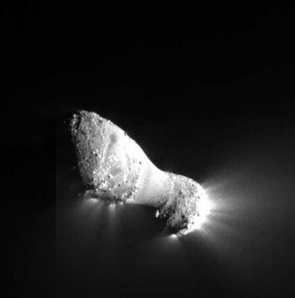A History of Comets - Part 4
Triumphs of the space age: Rendezvous with a comet
Advances in technology towards the end of the twentieth century provided exciting new opportunities for comet scientists. Whereas before scientists had relied solely on ground-based telescopes to observe and study comets, now there was the novel opportunity to approach these icy bodies as they journeyed towards the inner regions of the Solar System, passing relatively close to Earth.
Closing in on comets
In 1985, NASA's International Cometary Explorer (ICE) became the first space mission to approach a comet, passing approximately 7800 kilometres from the nucleus of Comet 21P/Giacobini-Zinner. Just one year later, when Halley's Comet returned to the vicinity of the Sun, an armada of spacecraft was sent to study the comet up close: these included two probes from Russia (Vega-1 and Vega-2), two from Japan (Sakigake and Suisei), and ESA's Giotto spacecraft.
Named after the Italian painter who, in 1303, depicted the star of Bethlehem as a comet, the Giotto mission obtained the closest pictures ever taken of a comet. After Vega-1 and Vega-2 came within 8900 and 8000 kilometres respectively from the nucleus of Halley's Comet in early March 1986, ESA scientists and engineers used the telemetry data from these probes to guide the Giotto spacecraft even closer.
Close encounters
 |
| The nucleus of Comet Halley by ESA's Giotto in 1986, from a distance of about 2000 km. Credit: ESA/MPS. |
On 13 March 1986, Giotto flew past the comet's nucleus at a distance of less than 600 kilometres, relaying unprecedented images of an extremely dark potato-shaped object with a size of about 15 by 7.2 by 7.2 kilometres. Giotto got to relive this comet-skimming experience just a handful of years later in 1992 when it flew by Comet 26P/Grigg-Skjellerup, whose nucleus is only a couple of kilometres wide, passing just 200 kilometres from its surface.
Since the turn of the new millennium, four more comets have been visited by various NASA spacecraft. In 2001, the Deep Space 1 mission encountered and imaged Comet 19P/Borrelly. A few years later in 2004, the Stardust mission flew by Comet 81P/Wild (also known as Wild 2), collecting samples from the comet's coma and returning them to Earth via a sample-return capsule in 2006.
Comet 9P/Tempel (also known as Tempel 1) was then visited by the Deep Impact mission in 2005, which recorded images and data, and later dropped an impactor onto its surface to study the composition of the subsurface. In a later extension of this mission, named EPOXI, one of its two craft flew by Comet 103P/Hartley (also known as Hartley 2) in 2010. The Stardust mission was also extended and, as Stardust-NExT, it visited Comet 9P/Tempel in 2011, imaging the crater that had been created six years earlier by Deep Impact.
 |
 |
| Comet Tempel-1, by NASA's Deep Impact in 2005. The image is a composite built from scaling images to 5 metres/pixel. The nucleus is 7.6 × 5 km. Credit: NASA/JPL/UMD | Comet Hartley-2 by NASA's EPOXI in 2010, from a distance of about 700 km. The nucleus is 2.2 km long. Credit: NASA/JPL-Caltech/UMD |
The stage is set
These missions to comets have provided important insights into the nature and origins of these celestial wanderers but comets have not yet given up all of their secrets.
 |
| The Rosetta Stone. Courtesy of the British Museum. |
As the most primitive objects in our cosmic neighbourhood, comets likely hold, in their icy interiors, some clues to processes that occurred during the early phases of our Solar System. This is where Rosetta, ESA's mission for cometary science, will play a major role.
The mission is named after the Rosetta Stone, an ancient Egyptian stele from the second century BC that was unearthed near Rashid (Rosetta) on the Nile delta in 1799. Famous for carrying the same text inscribed in three different languages – ancient Egyptian hieroglyphics, Demotic script (an everyday form of Egyptian) and ancient Greek - the stone allowed archeologists to decipher hieroglyphics for the first time. Rosetta's lander Philae is named after an island in the Nile river, where archeologists found an inscription on an obelisk that helped in deciphering the Rosetta stone.
Scientists hope that by studying a comet up close and for an extended period of time that this modern-day Rosetta will unlock secrets of how the Solar System formed.
Living with a comet
 |
|
Rosetta and Philae at comet 67P. Credit: ESA/ATG medialab; Comet image: ESA/Rosetta/NavCam |
Launched on 2 March 2004, Rosetta spent more than ten years travelling through space, flying past rocky asteroids and some of our neighbouring planets before reaching its target, Comet 67P/Churyumov-Gerasimenko, on 6 August 2014. The spacecraft will study the comet in unprecedented detail, deploy the lander Philae onto its surface, and follow the comet for over a year as it orbits the Sun.
With such ambitious tasks ahead, Rosetta will enter boldly into the long story of humankind and comets. Many mysteries about how our Solar System formed and evolved are still waiting to be unlocked, including fundamental questions about the role of water and the origin of life on Earth. A truly historic mission, Rosetta may help us to find some of these answers. Stay tuned!
| < |
A History of Comets - Part 3: On the origin of comets |
|||
